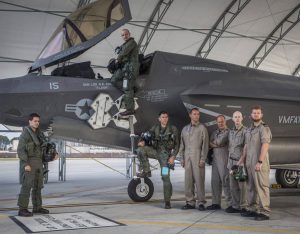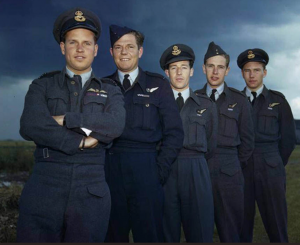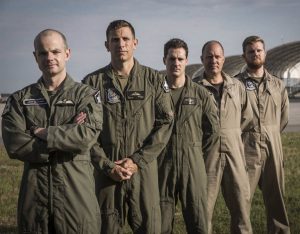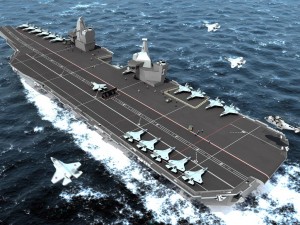RAF Wing Commander John Butcher
With the recent standup of the first UK F-35 squadron this month, we thought it made sense to go back to last year when we visited RAF Marham and met with team preparing for the F-35s arrival in the UK this year. Wing Commander Butcher provided a number of insights with regard to the standup of the squadron and way ahead.
On April 18, 2018, a story on the UK Ministry of Defense’s website announced the official standup of the F-35 squadron.
RAF’s legendary Dambusters squadron reforms to fly F-35 jets
The squadron immortalised by the Dambusters raid of World War II has been reformed to fly the UK’s new F-35 fighter jets, the Defence Secretary has announced.
Gavin Williamson announced the new 617 Squadron after an event in Washington DC to mark the centenary of the RAF, which was attended by Chief of the Air Staff, Air Chief Marshal Sir Stephen Hillier.
The naming of the new 617 Squadron follows the 75th anniversary of the original formation of the squadron, commonly referred to as the ‘Dambusters’. Originally set up for the highly-specialised mission to knock out dams and disrupt industrial production in the Ruhr Valley of Germany, the new 617 Squadron will be the first to fly the UK’s brand new, state-of-the-art F-35 fighter jets – the most advanced and dynamic fighter aircraft in the RAF’s 100-year history.
Defence Secretary Gavin Williamson said:
“The 617 Squadron name was made famous by ‘The Dambusters’, who played such a vital role in the Second World War. So it is fitting that by flying the world’s most advanced fighter jets, our new squadron will be ensuring that the legend of world-leading air power lives on.
“The F-35B Lightning will defend our nation and ensure that Britain remains a pioneer in innovation, with a unique ability to adapt to this increasingly dangerous world.”
The UK is currently flying the F-35B Lightning, a multi-role fighter jet capable of a wide range of operations. It is the world’s first jet to combine radar evading stealth technology with supersonic speeds and short take-off and landing capability.
Lightning Force Commander Air Commodore David Bradshaw said:
“This is a most momentous day for the UK Lightning Force as we celebrate the reformation of 617 Squadron. Manned by highly capable Royal Air Force and Royal Navy personnel and equipped with the truly remarkable F-35B Lightning, 617 Squadron will once again provide potent, flexible Air Power for the nation.
“In a simple yet highly significant ceremony held in the heart of Washington DC amongst friends and colleagues as part of celebrations for RAF100, the famous Dambusters marked the start of another exciting chapter in their Squadron’s proud history. I very much look forward to welcoming 617 Squadron home to RAF Marham this summer as they prepare for operational service from land and sea.”

On the 17 April 2018 617 Dambusters Squadron was reformed in Washington DC.
The Squadron Standard was paraded before the Chief of the Air Staff, Air Chief Marshal Sir Stephen Hillier, before Officer Commanding 617 Squadron, Wing Commander John Butcher asked for permission to reform the squadron.
Pilots and ground crew have for the past few years been training in the United States on the F-35B Lightning stealth aircraft and will soon return to RAF Marham, the unit’s future home. 617 Squadron has become the first front line squadron and is manned by both Royal Air Force and Royal Navy personnel.
The Dambusters
Wing Commander Guy Gibson hand-picked his bomber crews for the original 617-squadron, who then went on to deploy the iconic ‘bouncing bomb’ which had to be dropped above the water at an exact height of 60 feet and a speed of 220mph. The crews successfully managed to breach the Mohne and Eder dams.
Today’s 617 Squadron
Today’s 617 Squadron, currently training with the UK’s 15 F-35B Lightning jets in America, will move to the UK with a number of aircraft to their new home at RAF Marham this Summer. Like their predecessors they will be operating at the forefront of aircraft technology.
The aircraft will be jointly operated by the Royal Air Force and the Royal Navy and have the ability to operate from land and sea, forming an integral part of Carrier Strike operating from the Queen Elizabeth Class aircraft carriers.
In our interview last year with the RAF Marham team, the coming of the F-35 to the RAF and to the Royal Navy was detailed.
The interview was first published on 2017-04-13 and excerpts from that interview follow:
RAF Marham will have a fully operational, training and support capability.
Training, maintenance and various centers are being stood up.
At the heart of the effort will be the National Operations Center in which logistics and operations are collocated and the U.S. will have personnel in this center as well.
According to Wing Commander Butcher: “Within the National Operating Center, you essentially have two main functions.
There’s what we’re calling the Logistics Operating Center, and the Lightning Force Headquarters.

“The two of those together create the National Operating Center.
“Within the Logistics Operating Center, or the LOC, you have some very key elements of the Lightning project team that are currently based out of Abbeywood.
“The people who are doing the engineering supervision, the acquisition of the facilities, acquisition of the parts, the management of the supply chain, many of these will move to Marham and will sit alongside key industry partners.
“We have as well the Lightning Force Headquarters built within that same facility. Now if you plug in the USAF into that as well, which is our plan right now, then you have a very joint UK F-35 outlook with regard to the entire enterprise.”
There are multiple synergies involved with the F-35 and the standup of the Marham Air Base.
The first is the synergy from America to the United Kingdom and back again.
The UK has operators at Pax River, Edwards, Eglin and Beaufort Marine Corps Air Station.
17 Squadron at Edwards is a Test and Evaluation squadron and because the F-35 is a software upgradeable aircraft, tests will be a fact of life as the capabilities of the aircraft evolve over time, and the Brits are well placed at Edwards to be participants in this process. It should also be noted that the Dutch are on the ground floor with the Brits in this process as well as the Aussies.
The UK and the USMC are fully pooled at Beaufort with Marines flying British planes and vice versa. While there the Brits use the US Navy logistics system to support the F-35B whereas at Edwards they use the British system, so are learning how to work within both systems.
The Eglin engagement with the Canadians and Australians involved is with the reprogramming lab. “In effect, this is the apps center for the evolution of the software,” according to Commander Butcher.
According to Wing Commander Bucher, the build up at Beaufort will continue until mid-2018 when personnel will gradually transfer to Edwards or other facilities in the United States or come back to the UK.
“We will peak out at about 200 persons at Beaufort. We will bring 9 of our jets back next summer and five more later in the year.”
All of these bases are key elements in the UK element of the F-35 global enterprise.
The planes coming from Beaufort will provide the standup for the first RAF squadron. 617 squadron will be stood up next year as the Brits move from Beaufort to Marham.
The second synergy is between the standup among bases and lessons learned.
Marham is being stood up and generating operational lessons learned back to the United States, both in terms of the U.S.’s standup of its own bases abroad and at home, and, notably in terms of shaping a new operational dynamic for RAF Lakenheath.
The USAF F-35s at Lakenheath can become integrated into the operational, training and support elements in the UK as well, shaping a new approach for the USAF as well.
As Wing Commander Butcher underscored the possibilities:
“We want to take forwards everything that we’ve done in the pooling and implementation agreement in the United States, and try and see how we can transpose that into a UK model.

“We’re looking to have jets taking off, F-35A’s taking off at Lakenheath. Well, what if they have an issue and they need to land in Marham. Rather than take the time to move people, spares etc from Lakenheath up to here, what’s to say that we couldn’t conceptually have some maintainers from 617 Squadron repair the jet, sign off, send it flying again.
“Lakenheath is going to be busy base with the closure of Mildenhall. Increased efficiencies working with us would make sense.
“Could we potentially have F-35As operating out of Marham on a daily basis?
“How do we organize hot pit operations on each other’s base?
“One can easily see how that could buy you a lot of combat flexibility, in terms of how you might do maintenance operations.”

Commander Butcher noted that in the working group with Lakenheath, a 06-level maintainer is embedded in the UK Lightning Force Headquarters.
“He’s come in to do the interim scoping for how we might integrate the USAF into the Lightning Force headquarters facility, in particular the National Operating Center.”
Embedded in this synergy is a close working relationship with the USMC as well which can be seen at Beaufort or on the LHAs preparing for F-35B operations.
There is also a close working relationship between the new carrier community in the UK and with the US Navy as many UK officers have trained and operated aboard US carriers learning the US approach to the use of carriers, and shaping their thinking as well with regard to shaping their own approach to carrier operations with the F-35B.
The third synergy is between the Royal Navy and the Royal Air Force.
The UK is standing up a Lightning Force, not a RAF or Royal Navy force. The first two squadrons are being established on a 58/42 basis between RAF and RN pilots.
The first squadron, which will start the move from Beaufort in mid-2018 with full IOC by the end of 2018, will be badged as an RAF squadron and headed by an RAF officer (Wing Commander Butcher) who will be then relieved when the time comes by a RN officer.
And for the next two years, the squadron will work on integration with the Queen Elizabeth class carriers.
 Credit: Aircraft Carrier Alliance – Queen Elizabeth Class at sea (CGI)
Credit: Aircraft Carrier Alliance – Queen Elizabeth Class at sea (CGI)
According to Wing Commander Butcher: “We are focused on the defense product, not the service one when it comes to the Lightning Force. It is important to do our business as a Lightning Force.”
The second front line F35B squadron, 809 Squadron, will establish at Marham and badged as a Royal Navy squadron with a RN officer in charge who could then relieved when the time comes by an RAF officer.
The fourth synergy is building the base while the three Tornado squadrons are operationally involved and on a busy schedule supporting RAF operations worldwide, notably in the Middle East.
This means that Tornado infrastructure not only needs to be maintained but not leveraged in any way until those squadrons leave Marham.
This means that the next Marham base Commander Group Captain Townsend will be charged with standing up the base for F-35Bs, the squadron arriving in two parts, and keeping the key strike function of Tornado operational until the very end.
It can be disruptive but the ops tempo of the base is the key determinant of the effort; not simply erecting new buildings for a new aircraft.
The fifth synergy is between the base and the new Queen Elizabeth Class Carriers.
The new carriers are coming on line concurrently with the base becoming operational and sea trials and preparing for the integration of the F-35 with the new carriers.
And this base will provide a key element of shaping the outreach from the UK into Northern Europe as well as Norway, Denmark and the Dutch Air Forces come on line with their F-35s as well.
In other words, standing up the base at Marham is part of a significant strategic effort by the UK and at the heart of shaping 21t century approaches to deterrence.
When joined with what is happening from Lossie, to Iceland to Norway with P-8s, the upgrades to Typhoon, which will make it a core complement to the F-35B fleet and the reshaping of the ISTAR fleet at RAF Waddington, major changes are coming to the UK air and naval forces…..
Featured photo shows the Dambusters Squadron, 2017. Credit: Daily Express

